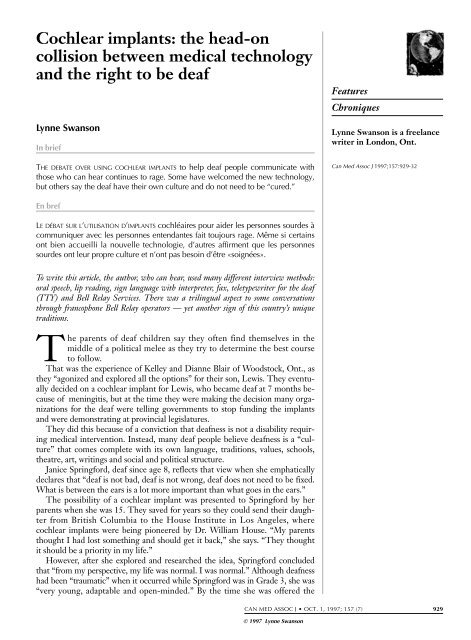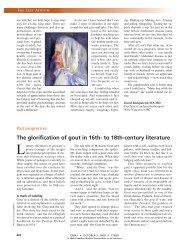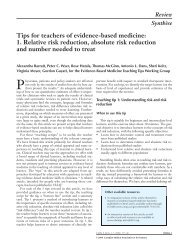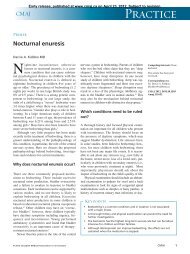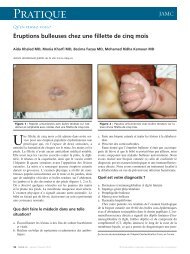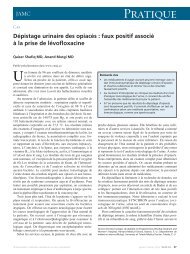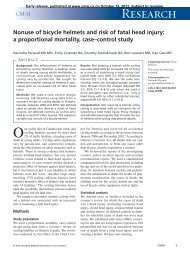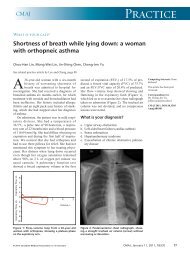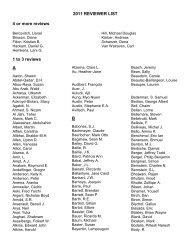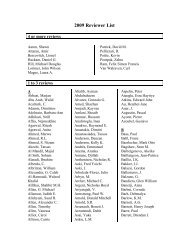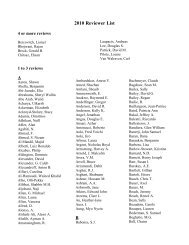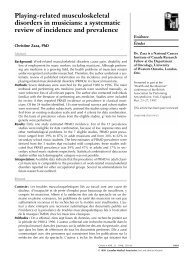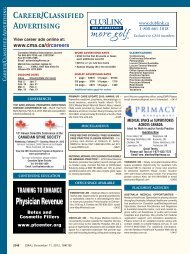Cochlear implants: the head-on collision between medical ...
Cochlear implants: the head-on collision between medical ...
Cochlear implants: the head-on collision between medical ...
Create successful ePaper yourself
Turn your PDF publications into a flip-book with our unique Google optimized e-Paper software.
<str<strong>on</strong>g>Cochlear</str<strong>on</strong>g> <str<strong>on</strong>g>implants</str<strong>on</strong>g>: <str<strong>on</strong>g>the</str<strong>on</strong>g> <str<strong>on</strong>g>head</str<strong>on</strong>g>-<strong>on</strong><br />
collisi<strong>on</strong> <strong>between</strong> <strong>medical</strong> technology<br />
and <str<strong>on</strong>g>the</str<strong>on</strong>g> right to be deaf<br />
Lynne Swans<strong>on</strong><br />
In brief<br />
THE DEBATE OVER USING COCHLEAR IMPLANTS to help deaf people communicate with<br />
those who can hear c<strong>on</strong>tinues to rage. Some have welcomed <str<strong>on</strong>g>the</str<strong>on</strong>g> new technology,<br />
but o<str<strong>on</strong>g>the</str<strong>on</strong>g>rs say <str<strong>on</strong>g>the</str<strong>on</strong>g> deaf have <str<strong>on</strong>g>the</str<strong>on</strong>g>ir own culture and do not need to be “cured.”<br />
Features<br />
Chr<strong>on</strong>iques<br />
Lynne Swans<strong>on</strong> is a freelance<br />
writer in L<strong>on</strong>d<strong>on</strong>, Ont.<br />
Can Med Assoc J 1997;157:929-32<br />
En bref<br />
LE DÉBAT SUR L’UTILISATION D’IMPLANTS cochléaires pour aider les pers<strong>on</strong>nes sourdes à<br />
communiquer avec les pers<strong>on</strong>nes entendantes fait toujours rage. Même si certains<br />
<strong>on</strong>t bien accueilli la nouvelle technologie, d’autres affirment que les pers<strong>on</strong>nes<br />
sourdes <strong>on</strong>t leur propre culture et n’<strong>on</strong>t pas besoin d’être «soignées».<br />
To write this article, <str<strong>on</strong>g>the</str<strong>on</strong>g> author, who can hear, used many different interview methods:<br />
oral speech, lip reading, sign language with interpreter, fax, teletypewriter for <str<strong>on</strong>g>the</str<strong>on</strong>g> deaf<br />
(TTY) and Bell Relay Services. There was a trilingual aspect to some c<strong>on</strong>versati<strong>on</strong>s<br />
through francoph<strong>on</strong>e Bell Relay operators — yet ano<str<strong>on</strong>g>the</str<strong>on</strong>g>r sign of this country’s unique<br />
traditi<strong>on</strong>s.<br />
The parents of deaf children say <str<strong>on</strong>g>the</str<strong>on</strong>g>y often find <str<strong>on</strong>g>the</str<strong>on</strong>g>mselves in <str<strong>on</strong>g>the</str<strong>on</strong>g><br />
middle of a political melee as <str<strong>on</strong>g>the</str<strong>on</strong>g>y try to determine <str<strong>on</strong>g>the</str<strong>on</strong>g> best course<br />
to follow.<br />
That was <str<strong>on</strong>g>the</str<strong>on</strong>g> experience of Kelley and Dianne Blair of Woodstock, Ont., as<br />
<str<strong>on</strong>g>the</str<strong>on</strong>g>y “ag<strong>on</strong>ized and explored all <str<strong>on</strong>g>the</str<strong>on</strong>g> opti<strong>on</strong>s” for <str<strong>on</strong>g>the</str<strong>on</strong>g>ir s<strong>on</strong>, Lewis. They eventually<br />
decided <strong>on</strong> a cochlear implant for Lewis, who became deaf at 7 m<strong>on</strong>ths because<br />
of meningitis, but at <str<strong>on</strong>g>the</str<strong>on</strong>g> time <str<strong>on</strong>g>the</str<strong>on</strong>g>y were making <str<strong>on</strong>g>the</str<strong>on</strong>g> decisi<strong>on</strong> many organizati<strong>on</strong>s<br />
for <str<strong>on</strong>g>the</str<strong>on</strong>g> deaf were telling governments to stop funding <str<strong>on</strong>g>the</str<strong>on</strong>g> <str<strong>on</strong>g>implants</str<strong>on</strong>g><br />
and were dem<strong>on</strong>strating at provincial legislatures.<br />
They did this because of a c<strong>on</strong>victi<strong>on</strong> that deafness is not a disability requiring<br />
<strong>medical</strong> interventi<strong>on</strong>. Instead, many deaf people believe deafness is a “culture”<br />
that comes complete with its own language, traditi<strong>on</strong>s, values, schools,<br />
<str<strong>on</strong>g>the</str<strong>on</strong>g>atre, art, writings and social and political structure.<br />
Janice Springford, deaf since age 8, reflects that view when she emphatically<br />
declares that “deaf is not bad, deaf is not wr<strong>on</strong>g, deaf does not need to be fixed.<br />
What is <strong>between</strong> <str<strong>on</strong>g>the</str<strong>on</strong>g> ears is a lot more important than what goes in <str<strong>on</strong>g>the</str<strong>on</strong>g> ears.”<br />
The possibility of a cochlear implant was presented to Springford by her<br />
parents when she was 15. They saved for years so <str<strong>on</strong>g>the</str<strong>on</strong>g>y could send <str<strong>on</strong>g>the</str<strong>on</strong>g>ir daughter<br />
from British Columbia to <str<strong>on</strong>g>the</str<strong>on</strong>g> House Institute in Los Angeles, where<br />
cochlear <str<strong>on</strong>g>implants</str<strong>on</strong>g> were being pi<strong>on</strong>eered by Dr. William House. “My parents<br />
thought I had lost something and should get it back,” she says. “They thought<br />
it should be a priority in my life.”<br />
However, after she explored and researched <str<strong>on</strong>g>the</str<strong>on</strong>g> idea, Springford c<strong>on</strong>cluded<br />
that “from my perspective, my life was normal. I was normal.” Although deafness<br />
had been “traumatic” when it occurred while Springford was in Grade 3, she was<br />
“very young, adaptable and open-minded.” By <str<strong>on</strong>g>the</str<strong>on</strong>g> time she was offered <str<strong>on</strong>g>the</str<strong>on</strong>g><br />
CAN MED ASSOC J • OCT. 1, 1997; 157 (7) 929<br />
© 1997 Lynne Swans<strong>on</strong>
Swans<strong>on</strong><br />
Bill Ir<strong>on</strong>side, L<strong>on</strong>d<strong>on</strong> Free Press<br />
Dianne Blair holds s<strong>on</strong> Lewis, who has a cochlear implant, as<br />
his bro<str<strong>on</strong>g>the</str<strong>on</strong>g>rs Liam (left) and Sam look <strong>on</strong><br />
cochlear implant she was an adolescent well adjusted to<br />
deafness. She declined.<br />
She went <strong>on</strong> to obtain a degree in psychology from<br />
<str<strong>on</strong>g>the</str<strong>on</strong>g> University of British Columbia and today teaches at<br />
an Ontario school for <str<strong>on</strong>g>the</str<strong>on</strong>g> deaf. Now 31, Springford has<br />
not regretted her decisi<strong>on</strong>, “not <strong>on</strong>ce, not for a single<br />
solitary sec<strong>on</strong>d. Parents are often so c<strong>on</strong>cerned that <str<strong>on</strong>g>the</str<strong>on</strong>g><br />
child is handicapped that <str<strong>on</strong>g>the</str<strong>on</strong>g>y may not see all <str<strong>on</strong>g>the</str<strong>on</strong>g><br />
choices and possibilities open to <str<strong>on</strong>g>the</str<strong>on</strong>g>m.”<br />
“Giving Lewis all <str<strong>on</strong>g>the</str<strong>on</strong>g> opportunity we could” was why<br />
<str<strong>on</strong>g>the</str<strong>on</strong>g> Blairs decided <str<strong>on</strong>g>the</str<strong>on</strong>g>ir s<strong>on</strong> would have an implant; 2 attempts<br />
to use hearing aids had failed. His parents had<br />
c<strong>on</strong>sidered lip reading and sign language, and <str<strong>on</strong>g>the</str<strong>on</strong>g>y had<br />
tried <str<strong>on</strong>g>the</str<strong>on</strong>g> auditory-verbal approach that employs residual<br />
hearing, but results were discouraging.<br />
“We felt if Lewis had some hearing and some language,<br />
it would give him more opti<strong>on</strong>s than if we pursued<br />
just sign language,” says his mo<str<strong>on</strong>g>the</str<strong>on</strong>g>r.<br />
“This decisi<strong>on</strong> was not taken lightly,” adds his fa<str<strong>on</strong>g>the</str<strong>on</strong>g>r.<br />
At age 2, Lewis received his cochlear implant at University<br />
Hospital in L<strong>on</strong>d<strong>on</strong>, Ont. Three years after <str<strong>on</strong>g>the</str<strong>on</strong>g><br />
surgery, his parents are c<strong>on</strong>vinced <str<strong>on</strong>g>the</str<strong>on</strong>g>y made <str<strong>on</strong>g>the</str<strong>on</strong>g> right decisi<strong>on</strong>.<br />
[In L<strong>on</strong>d<strong>on</strong> <str<strong>on</strong>g>the</str<strong>on</strong>g> procedure costs $36 748, including<br />
<str<strong>on</strong>g>the</str<strong>on</strong>g> cost of <str<strong>on</strong>g>the</str<strong>on</strong>g> implant and 2 days in hospital. — Ed.]<br />
Following surgery, he received intensive auditory-verbal<br />
training, attended a preschool for hearing-impaired<br />
children and had daily less<strong>on</strong>s at home. He recently<br />
scored well above his age group in a standardized language<br />
test.<br />
Kelley Blair says newer, 22-channel <str<strong>on</strong>g>implants</str<strong>on</strong>g> mean his<br />
s<strong>on</strong> “can detect and articulate far more of <str<strong>on</strong>g>the</str<strong>on</strong>g> frequency<br />
range. . . . He speaks in full sentences and his speech is<br />
clear and distinctive. He hears <str<strong>on</strong>g>the</str<strong>on</strong>g> full spectrum of sound<br />
. . . and his audiogram [results indicate that] he can hear<br />
low, high and middle frequencies all about basically <str<strong>on</strong>g>the</str<strong>on</strong>g><br />
same as a normal pers<strong>on</strong>, except he can’t hear <str<strong>on</strong>g>the</str<strong>on</strong>g>m as well.<br />
“It’s quite amazing what Lewis has d<strong>on</strong>e, and <str<strong>on</strong>g>the</str<strong>on</strong>g>re<br />
are o<str<strong>on</strong>g>the</str<strong>on</strong>g>r kids who have had <str<strong>on</strong>g>the</str<strong>on</strong>g> same results or better.<br />
The implant is a phenomenal device.”<br />
Dr. Lorne Parnes, <str<strong>on</strong>g>the</str<strong>on</strong>g> otolaryngologist who performed<br />
Lewis’ implant — he has completed <str<strong>on</strong>g>the</str<strong>on</strong>g> procedure<br />
about 65 times — says cochlear <str<strong>on</strong>g>implants</str<strong>on</strong>g> involve a<br />
“pers<strong>on</strong>al choice.” They are frequently chosen by hearing<br />
patients who become deaf as adults and “want to get<br />
back into hearing society.” Although <str<strong>on</strong>g>the</str<strong>on</strong>g>y may not restore<br />
full hearing, <str<strong>on</strong>g>the</str<strong>on</strong>g>y allow <str<strong>on</strong>g>the</str<strong>on</strong>g>m to do that.<br />
Parnes says 80% to 90% of deaf children live with<br />
hearing parents and siblings. “It’s <str<strong>on</strong>g>the</str<strong>on</strong>g> decisi<strong>on</strong> of parents<br />
to make whe<str<strong>on</strong>g>the</str<strong>on</strong>g>r <str<strong>on</strong>g>the</str<strong>on</strong>g>ir children should be part of <str<strong>on</strong>g>the</str<strong>on</strong>g><br />
hearing or deaf society,” he says. “We as parents are c<strong>on</strong>stantly<br />
making decisi<strong>on</strong>s about our children’s well-being,<br />
and this is <strong>on</strong>e <str<strong>on</strong>g>the</str<strong>on</strong>g>m.”<br />
He says parents wanting to make an informed choice<br />
will examine all <str<strong>on</strong>g>the</str<strong>on</strong>g> opti<strong>on</strong>s open to <str<strong>on</strong>g>the</str<strong>on</strong>g>ir child, including<br />
deaf culture. Parnes says most deaf parents of a deaf<br />
child are unlikely to even c<strong>on</strong>sider a cochlear implant,<br />
and adults who have been deaf since birth are unlikely to<br />
c<strong>on</strong>template it for <str<strong>on</strong>g>the</str<strong>on</strong>g>mselves.<br />
Parnes thinks <str<strong>on</strong>g>the</str<strong>on</strong>g> c<strong>on</strong>troversy surrounding cochlear<br />
<str<strong>on</strong>g>implants</str<strong>on</strong>g> may be lessening. “If you look at people who<br />
have had <str<strong>on</strong>g>the</str<strong>on</strong>g> <str<strong>on</strong>g>implants</str<strong>on</strong>g>, you can’t argue with success.”<br />
A deaf physician<br />
Dr. Hartley Bressler, a Thornhill, Ont., family physician<br />
who has been deaf since birth, sees both hearing and<br />
deaf patients in his practice and remains c<strong>on</strong>cerned about<br />
media reports that tell of “star cochlear implant recipients.<br />
The news <str<strong>on</strong>g>head</str<strong>on</strong>g>lines sensati<strong>on</strong>alize <strong>on</strong>e child’s ‘miracle of<br />
hearing,’ but <str<strong>on</strong>g>the</str<strong>on</strong>g> failures are never portrayed. I understand<br />
that most parents want <str<strong>on</strong>g>the</str<strong>on</strong>g> best for <str<strong>on</strong>g>the</str<strong>on</strong>g>ir deaf child,<br />
but good intenti<strong>on</strong>s do not guarantee success.”<br />
He argues that <strong>on</strong>e-<strong>on</strong>-<strong>on</strong>e testing by <str<strong>on</strong>g>the</str<strong>on</strong>g>rapists<br />
does not simulate “communicati<strong>on</strong>s most people experience<br />
in <str<strong>on</strong>g>the</str<strong>on</strong>g> hearing world. The research [c<strong>on</strong>cerning]<br />
cochlear <str<strong>on</strong>g>implants</str<strong>on</strong>g> is still in its relative infancy [and]<br />
<str<strong>on</strong>g>the</str<strong>on</strong>g>re are still too many unknowns and we are <strong>on</strong> a c<strong>on</strong>tinual<br />
learning curve as to its use, effectiveness and<br />
l<strong>on</strong>g-term ramificati<strong>on</strong>s.”<br />
930 CAN MED ASSOC J • 1 er OCT. 1997; 157 (7)
Deaf culture<br />
Although Bressler agrees that many adults are satisfied<br />
with <str<strong>on</strong>g>the</str<strong>on</strong>g>ir cochlear <str<strong>on</strong>g>implants</str<strong>on</strong>g>, he asks: “Should we<br />
really experiment <strong>on</strong> deaf children?”<br />
Of particular c<strong>on</strong>cern is <str<strong>on</strong>g>the</str<strong>on</strong>g> inability of a 2-year-old<br />
to provide feedback if an implant is causing problems.<br />
“All opti<strong>on</strong>s must be weighed very<br />
carefully.”<br />
Kristin Snodd<strong>on</strong>, <strong>on</strong>e of Canada’s<br />
first cochlear-implant recipients, recalls<br />
<str<strong>on</strong>g>the</str<strong>on</strong>g> period after she received her<br />
implant in 1990, at age 15, as “<str<strong>on</strong>g>the</str<strong>on</strong>g><br />
darkest period of my life. When my<br />
parents c<strong>on</strong>fr<strong>on</strong>ted me about this<br />
implant . . . I was shocked, because I<br />
did not think <str<strong>on</strong>g>the</str<strong>on</strong>g>re was anything<br />
wr<strong>on</strong>g with me physically, emoti<strong>on</strong>ally<br />
and mentally.”<br />
Despite being a popular straight<br />
A student in a mainstream classroom,<br />
“it was like my parents were<br />
telling me <str<strong>on</strong>g>the</str<strong>on</strong>g>re was something horribly<br />
wr<strong>on</strong>g with me.”<br />
Snodd<strong>on</strong>, deaf from age 5 because<br />
of meningitis, remembered<br />
sound and voices. She was disturbed<br />
that <str<strong>on</strong>g>the</str<strong>on</strong>g> implant was “not like hearing<br />
at all — it was like vibrating in<br />
my skull [and] was very annoying. I<br />
Kristin Snodd<strong>on</strong>: stopped using her implant<br />
have a lot of visual c<strong>on</strong>centrati<strong>on</strong> that keeps me very<br />
alert to my surroundings and <str<strong>on</strong>g>the</str<strong>on</strong>g> implant distracted me<br />
from what I could see.”<br />
Bressler is troubled that o<str<strong>on</strong>g>the</str<strong>on</strong>g>r deaf children may eventually<br />
share Springford’s and Snodd<strong>on</strong>’s reacti<strong>on</strong>s to what<br />
<str<strong>on</strong>g>the</str<strong>on</strong>g>ir parents have d<strong>on</strong>e or suggested. “Deafness is not<br />
something you should make a child feel defective or incomplete<br />
about,” he says. “I w<strong>on</strong>der about <str<strong>on</strong>g>the</str<strong>on</strong>g> future selfesteem<br />
of a child who is aware that she or he has underg<strong>on</strong>e<br />
major surgery for a pros<str<strong>on</strong>g>the</str<strong>on</strong>g>tic device, not to save life<br />
but to please parents.”<br />
Bressler knows that health care professi<strong>on</strong>als and <str<strong>on</strong>g>the</str<strong>on</strong>g><br />
deaf often see <str<strong>on</strong>g>the</str<strong>on</strong>g>se issues much differently.<br />
If a group of hearing physicians,<br />
psychologists, educators, audiologists<br />
and <str<strong>on</strong>g>the</str<strong>on</strong>g>rapists and a similar<br />
group of deaf professi<strong>on</strong>als “each<br />
write textbooks <strong>on</strong> <str<strong>on</strong>g>the</str<strong>on</strong>g> cochlear implant<br />
and its surrounding issues, I<br />
can assure you <str<strong>on</strong>g>the</str<strong>on</strong>g>y will be diametrically<br />
opposed.”<br />
Parents in <str<strong>on</strong>g>the</str<strong>on</strong>g> process of deciding<br />
what is in a child’s best interest will<br />
often be caught in <str<strong>on</strong>g>the</str<strong>on</strong>g> middle of this<br />
“mind-boggling” debate. Bressler,<br />
who frequently c<strong>on</strong>sults parents of<br />
deaf newborns or children, sometimes<br />
receives thick files of detailed<br />
reports from various specialists and<br />
educati<strong>on</strong>al experts.<br />
Even when a 3-year-old has not<br />
yet spoken, “not <strong>on</strong>e reference is<br />
made to <str<strong>on</strong>g>the</str<strong>on</strong>g> possibility of sign language<br />
or any suggesti<strong>on</strong> of meeting<br />
some<strong>on</strong>e in <str<strong>on</strong>g>the</str<strong>on</strong>g> deaf community.” Instead,<br />
<str<strong>on</strong>g>the</str<strong>on</strong>g>re will be a diagnosis of autism, pervasive developmental<br />
disorder “or some o<str<strong>on</strong>g>the</str<strong>on</strong>g>r esoteric diagnosis.<br />
“Parents <str<strong>on</strong>g>the</str<strong>on</strong>g>n tell me <str<strong>on</strong>g>the</str<strong>on</strong>g>y have never been introduced<br />
to <str<strong>on</strong>g>the</str<strong>on</strong>g> c<strong>on</strong>cept of signing and deaf culture,” says Bressler.<br />
“If <str<strong>on</strong>g>the</str<strong>on</strong>g>y are not interested, that’s fine, but at least <str<strong>on</strong>g>the</str<strong>on</strong>g>y<br />
should be told to invest a significant amount of time before<br />
deciding against it. I will support <str<strong>on</strong>g>the</str<strong>on</strong>g>m if <str<strong>on</strong>g>the</str<strong>on</strong>g>y want a<br />
<str<strong>on</strong>g>Cochlear</str<strong>on</strong>g> implant, yes or no?<br />
Deaf family physician Hartley Bressler says several<br />
questi<strong>on</strong>s should be answered before a decisi<strong>on</strong> is<br />
made to proceed with a cochlear implant. The questi<strong>on</strong>s<br />
c<strong>on</strong>cern <str<strong>on</strong>g>the</str<strong>on</strong>g> way a successful implant is defined.<br />
Will a successful implant mean I’ll be able to hear<br />
like hearing people?<br />
Is success <str<strong>on</strong>g>the</str<strong>on</strong>g> ability to communicate like hearing<br />
people, without any obstacles or barriers and without<br />
being dependent <strong>on</strong> assistance?<br />
Is <str<strong>on</strong>g>the</str<strong>on</strong>g> measure of successful language/communicati<strong>on</strong><br />
<str<strong>on</strong>g>the</str<strong>on</strong>g> ability to learn a word at a time after hours of<br />
repetitive rote learning?<br />
Are recipients using <str<strong>on</strong>g>the</str<strong>on</strong>g> implant as an adjunct for lip<br />
reading? (If <str<strong>on</strong>g>the</str<strong>on</strong>g> answer is yes, this cancels questi<strong>on</strong>s 1<br />
and 2.)<br />
Is success measured against <str<strong>on</strong>g>the</str<strong>on</strong>g> academic and educati<strong>on</strong>al<br />
achievements of hearing or deaf people?<br />
Finally, is success based <strong>on</strong> <str<strong>on</strong>g>the</str<strong>on</strong>g> noti<strong>on</strong> that a<br />
cochlear-implant recipient will be able to integrate into<br />
<str<strong>on</strong>g>the</str<strong>on</strong>g> hearing society as <strong>on</strong>e of its better, more successful<br />
and productive members?<br />
If an affirmative answer to <str<strong>on</strong>g>the</str<strong>on</strong>g> final questi<strong>on</strong> is used<br />
to define success, says Bressler, it means that “all <str<strong>on</strong>g>the</str<strong>on</strong>g><br />
successful deaf physicians, lawyers, PhDs and o<str<strong>on</strong>g>the</str<strong>on</strong>g>r<br />
professi<strong>on</strong>als in <str<strong>on</strong>g>the</str<strong>on</strong>g> world” have been discounted.<br />
CAN MED ASSOC J • OCT. 1, 1997; 157 (7) 931
Swans<strong>on</strong><br />
cochlear implant, but <strong>on</strong>ly if <str<strong>on</strong>g>the</str<strong>on</strong>g>re is true and legitimate<br />
informed c<strong>on</strong>sent.”<br />
For communicati<strong>on</strong> purposes, he advocates signing in<br />
additi<strong>on</strong> to speech, not <strong>on</strong>e or <str<strong>on</strong>g>the</str<strong>on</strong>g> o<str<strong>on</strong>g>the</str<strong>on</strong>g>r. “There is no<br />
evidence that learning to sign first will get in <str<strong>on</strong>g>the</str<strong>on</strong>g> way of<br />
speech training. In fact, it will enhance it.”<br />
Even if parents decide <strong>on</strong> a cochlear implant,<br />
Bressler suggests that learning American Sign Language<br />
(ASL) before verbal-auditory training will provide<br />
youngsters with language skills, and this can provide<br />
structure and fluidity when <str<strong>on</strong>g>the</str<strong>on</strong>g>y begin developing<br />
oral and written language skills.<br />
To promote informed c<strong>on</strong>sent, Bressler arranges for<br />
parents to meet deaf people. The first meeting will involve<br />
some<strong>on</strong>e with oral but not sign-language skills,<br />
and <str<strong>on</strong>g>the</str<strong>on</strong>g> next with a pers<strong>on</strong> who has <strong>on</strong>ly ASL. “Finally, I<br />
introduce <str<strong>on</strong>g>the</str<strong>on</strong>g>m to some<strong>on</strong>e who has both. They may<br />
not be sold <strong>on</strong> <strong>on</strong>e idea over <str<strong>on</strong>g>the</str<strong>on</strong>g> o<str<strong>on</strong>g>the</str<strong>on</strong>g>r, but this gives an<br />
idea of how people functi<strong>on</strong> as deaf adults. Parents are<br />
extremely appreciative of this eye-opening exposure. All<br />
opti<strong>on</strong>s should be placed <strong>on</strong> <str<strong>on</strong>g>the</str<strong>on</strong>g> table for all to see. No<br />
<strong>on</strong>e side is right and <str<strong>on</strong>g>the</str<strong>on</strong>g> o<str<strong>on</strong>g>the</str<strong>on</strong>g>r wr<strong>on</strong>g.”<br />
Chris Kenopic, president of <str<strong>on</strong>g>the</str<strong>on</strong>g> Ontario Associati<strong>on</strong><br />
of <str<strong>on</strong>g>the</str<strong>on</strong>g> Deaf (OAD), stresses that his organizati<strong>on</strong> agrees<br />
“parents have <str<strong>on</strong>g>the</str<strong>on</strong>g> right to decide what <str<strong>on</strong>g>the</str<strong>on</strong>g>y want for<br />
<str<strong>on</strong>g>the</str<strong>on</strong>g>ir child, as l<strong>on</strong>g as <str<strong>on</strong>g>the</str<strong>on</strong>g>y are provided <str<strong>on</strong>g>the</str<strong>on</strong>g> full informati<strong>on</strong><br />
and understand all <str<strong>on</strong>g>the</str<strong>on</strong>g> opti<strong>on</strong>s.”<br />
However, he thinks that because hearing society<br />
c<strong>on</strong>siders deafness “something that needs to be fixed,”<br />
specialists may not suggest all opti<strong>on</strong>s to parents.<br />
Kenopic emphasizes that OAD is not c<strong>on</strong>cerned about<br />
“losing [<str<strong>on</strong>g>the</str<strong>on</strong>g>] native language [ASL].” He is c<strong>on</strong>cerned<br />
that some physicians have used this argument, “making<br />
[parents] hesitate to meet deaf adults” to explore<br />
alternatives.<br />
The OAD recognizes that funding of cochlear <str<strong>on</strong>g>implants</str<strong>on</strong>g><br />
will c<strong>on</strong>tinue. Kenopic says efforts are now being<br />
made to make resources available to help hearing parents<br />
understand <str<strong>on</strong>g>the</str<strong>on</strong>g> needs of deaf children.<br />
Only now, 16 years after she became deaf, is Kristin<br />
Snodd<strong>on</strong> “breaking into deaf culture.” Ir<strong>on</strong>ically, it was<br />
<str<strong>on</strong>g>the</str<strong>on</strong>g> challenges that came with living with her 22-channel<br />
implant that led to her “awakening” as a deaf pers<strong>on</strong>.<br />
She stopped using <str<strong>on</strong>g>the</str<strong>on</strong>g> implant when she was 19, 4 years<br />
after receiving it. The same year she entered <str<strong>on</strong>g>the</str<strong>on</strong>g> University<br />
of Tor<strong>on</strong>to, where she graduated with an h<strong>on</strong>ours<br />
BA degree this spring.<br />
Although she learned some sign language, Snodd<strong>on</strong><br />
thought deaf people may have rejected her if <str<strong>on</strong>g>the</str<strong>on</strong>g>y knew<br />
about <str<strong>on</strong>g>the</str<strong>on</strong>g> implant. “It’s very difficult to be rejected by<br />
your peer group,” she says.<br />
Meeting o<str<strong>on</strong>g>the</str<strong>on</strong>g>r deaf people and discovering deaf culture<br />
proved a “totally revoluti<strong>on</strong>ary thing” with “a<br />
tremendous impact <strong>on</strong> every single area of [my] life,” she<br />
says. “I accept my differences now that I am aware of <str<strong>on</strong>g>the</str<strong>on</strong>g><br />
deaf culture. My self-esteem has really increased.”<br />
Snodd<strong>on</strong> required fur<str<strong>on</strong>g>the</str<strong>on</strong>g>r surgery last year to remove<br />
her implant because of a “life-threatening” complicati<strong>on</strong>.<br />
If her family had been helped to understand her as<br />
a deaf pers<strong>on</strong>, says Snodd<strong>on</strong>, many pers<strong>on</strong>al, emoti<strong>on</strong>al,<br />
<strong>medical</strong> and o<str<strong>on</strong>g>the</str<strong>on</strong>g>r problems may have been avoided.<br />
Despite <str<strong>on</strong>g>the</str<strong>on</strong>g> intensity of <str<strong>on</strong>g>the</str<strong>on</strong>g> c<strong>on</strong>troversy, Bressler thinks<br />
“we should have an open mind. I may have deafened ears,<br />
but <strong>on</strong>e must have open eyes to look at both <str<strong>on</strong>g>the</str<strong>on</strong>g> deaf side<br />
and <str<strong>on</strong>g>the</str<strong>on</strong>g> n<strong>on</strong>deaf side.” He hopes every<strong>on</strong>e becoming<br />
involved in <str<strong>on</strong>g>the</str<strong>on</strong>g> debate will enter it with eyes open. ß<br />
932 CAN MED ASSOC J • 1 er OCT. 1997; 157 (7)


